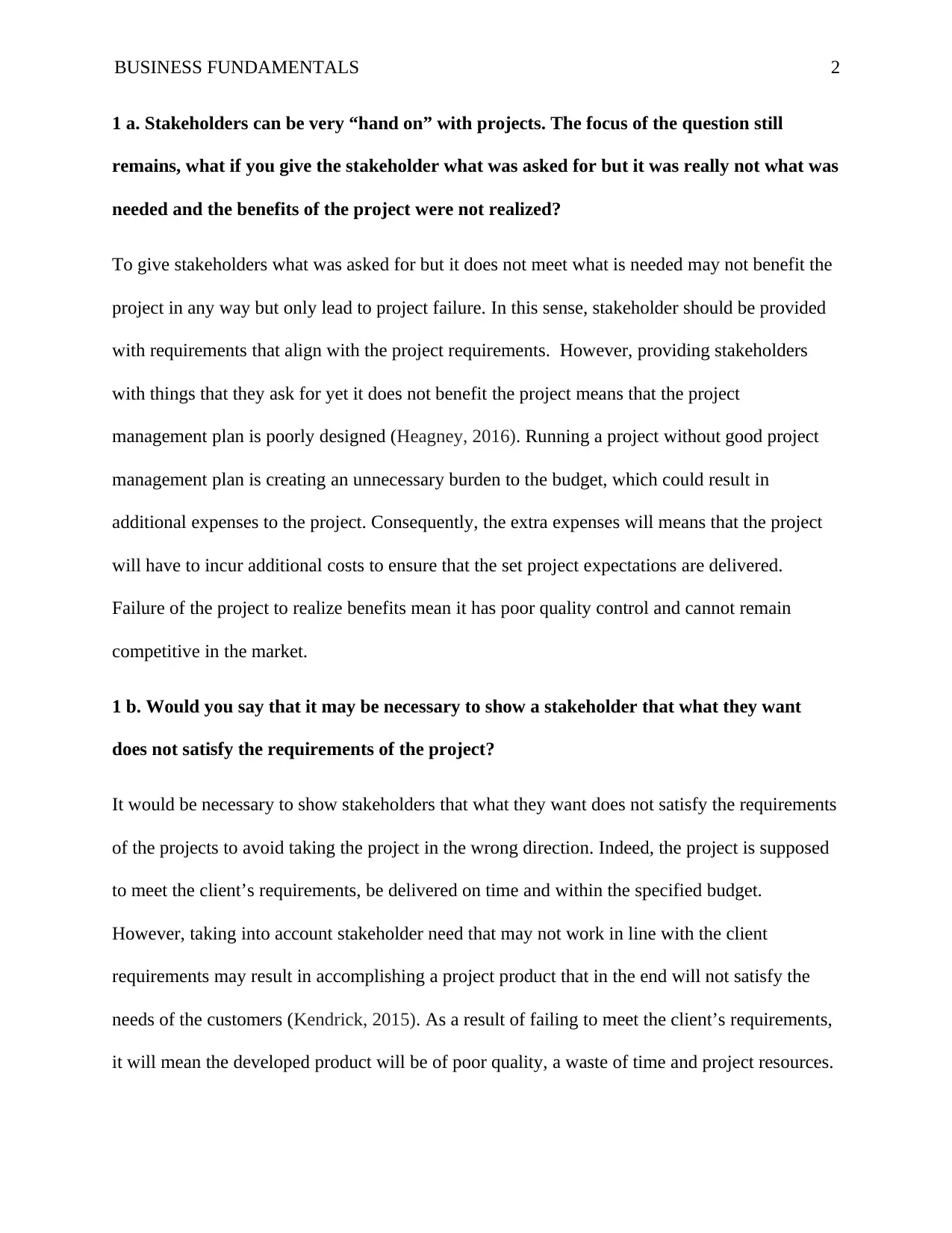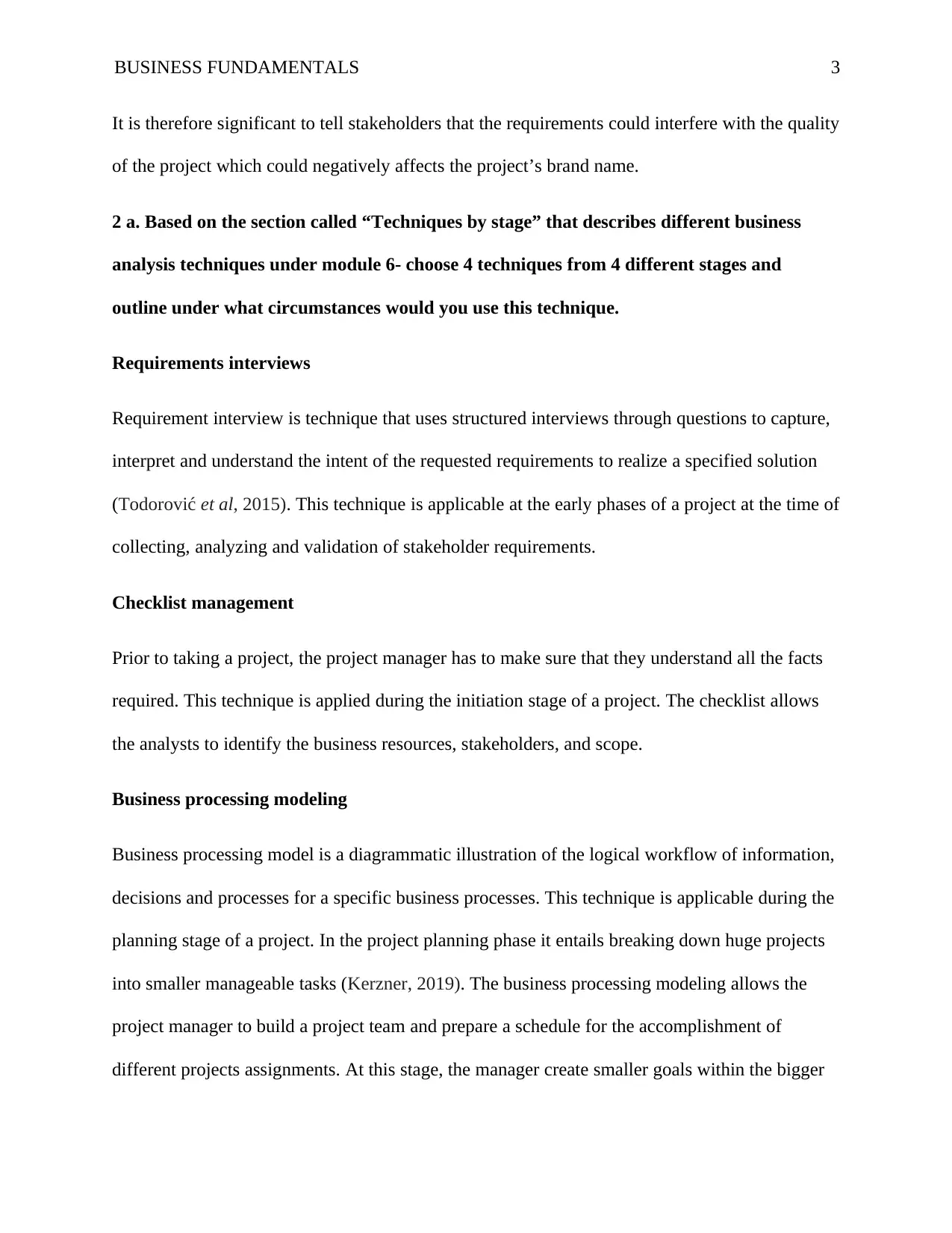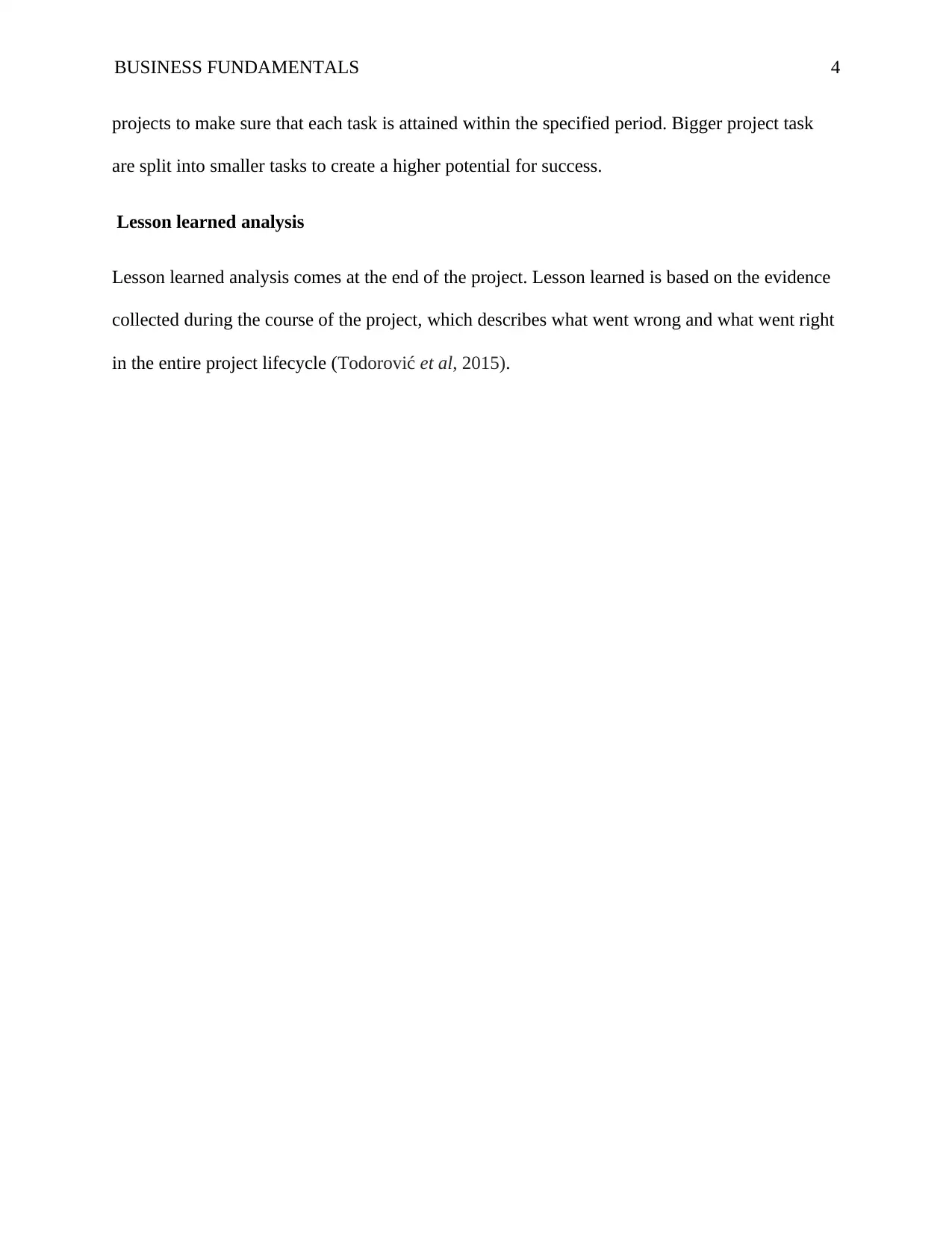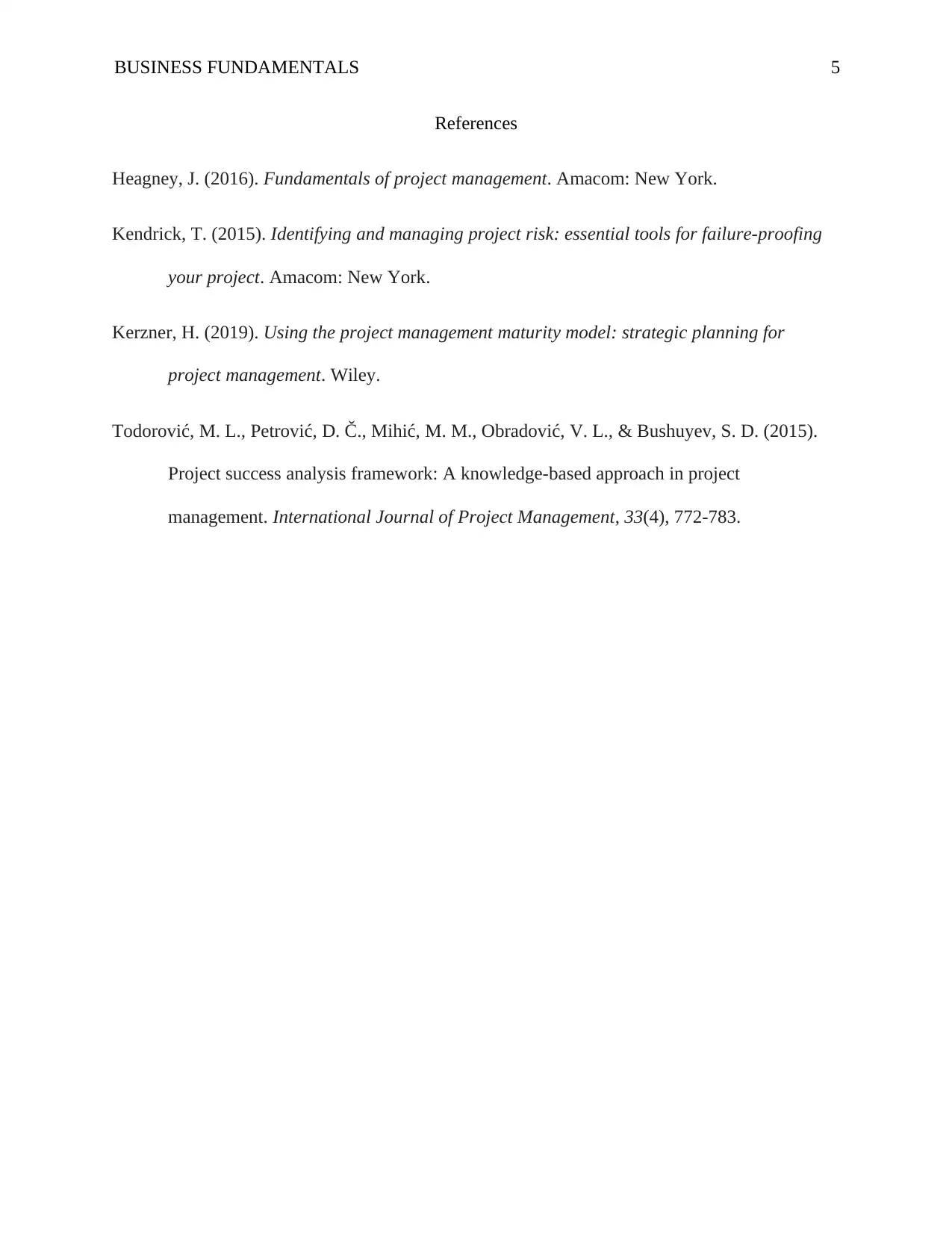Business Fundamentals: Project Techniques and Stakeholder Management
VerifiedAdded on 2022/10/03
|5
|854
|3
Homework Assignment
AI Summary
This assignment delves into the core concepts of business fundamentals, focusing on the critical aspects of stakeholder management and project techniques. The student explores scenarios where stakeholder requests might not align with project requirements, emphasizing the need for a well-defined project management plan to avoid project failures. The analysis covers the importance of communicating to stakeholders when their requests could negatively impact the project. The assignment also examines various business analysis techniques, including requirements interviews, checklist management, business process modeling, and lesson learned analysis, outlining their application in different project stages. References from Heagney, Kendrick, Kerzner, and Todorović et al. provide a comprehensive foundation for the analysis.

Running head: BUSINESS FUNDAMENTALS 1
Business Fundamentals
Student’s Name
Institutional Affiliation
Business Fundamentals
Student’s Name
Institutional Affiliation
Paraphrase This Document
Need a fresh take? Get an instant paraphrase of this document with our AI Paraphraser

BUSINESS FUNDAMENTALS 2
1 a. Stakeholders can be very “hand on” with projects. The focus of the question still
remains, what if you give the stakeholder what was asked for but it was really not what was
needed and the benefits of the project were not realized?
To give stakeholders what was asked for but it does not meet what is needed may not benefit the
project in any way but only lead to project failure. In this sense, stakeholder should be provided
with requirements that align with the project requirements. However, providing stakeholders
with things that they ask for yet it does not benefit the project means that the project
management plan is poorly designed (Heagney, 2016). Running a project without good project
management plan is creating an unnecessary burden to the budget, which could result in
additional expenses to the project. Consequently, the extra expenses will means that the project
will have to incur additional costs to ensure that the set project expectations are delivered.
Failure of the project to realize benefits mean it has poor quality control and cannot remain
competitive in the market.
1 b. Would you say that it may be necessary to show a stakeholder that what they want
does not satisfy the requirements of the project?
It would be necessary to show stakeholders that what they want does not satisfy the requirements
of the projects to avoid taking the project in the wrong direction. Indeed, the project is supposed
to meet the client’s requirements, be delivered on time and within the specified budget.
However, taking into account stakeholder need that may not work in line with the client
requirements may result in accomplishing a project product that in the end will not satisfy the
needs of the customers (Kendrick, 2015). As a result of failing to meet the client’s requirements,
it will mean the developed product will be of poor quality, a waste of time and project resources.
1 a. Stakeholders can be very “hand on” with projects. The focus of the question still
remains, what if you give the stakeholder what was asked for but it was really not what was
needed and the benefits of the project were not realized?
To give stakeholders what was asked for but it does not meet what is needed may not benefit the
project in any way but only lead to project failure. In this sense, stakeholder should be provided
with requirements that align with the project requirements. However, providing stakeholders
with things that they ask for yet it does not benefit the project means that the project
management plan is poorly designed (Heagney, 2016). Running a project without good project
management plan is creating an unnecessary burden to the budget, which could result in
additional expenses to the project. Consequently, the extra expenses will means that the project
will have to incur additional costs to ensure that the set project expectations are delivered.
Failure of the project to realize benefits mean it has poor quality control and cannot remain
competitive in the market.
1 b. Would you say that it may be necessary to show a stakeholder that what they want
does not satisfy the requirements of the project?
It would be necessary to show stakeholders that what they want does not satisfy the requirements
of the projects to avoid taking the project in the wrong direction. Indeed, the project is supposed
to meet the client’s requirements, be delivered on time and within the specified budget.
However, taking into account stakeholder need that may not work in line with the client
requirements may result in accomplishing a project product that in the end will not satisfy the
needs of the customers (Kendrick, 2015). As a result of failing to meet the client’s requirements,
it will mean the developed product will be of poor quality, a waste of time and project resources.

BUSINESS FUNDAMENTALS 3
It is therefore significant to tell stakeholders that the requirements could interfere with the quality
of the project which could negatively affects the project’s brand name.
2 a. Based on the section called “Techniques by stage” that describes different business
analysis techniques under module 6- choose 4 techniques from 4 different stages and
outline under what circumstances would you use this technique.
Requirements interviews
Requirement interview is technique that uses structured interviews through questions to capture,
interpret and understand the intent of the requested requirements to realize a specified solution
(Todorović et al, 2015). This technique is applicable at the early phases of a project at the time of
collecting, analyzing and validation of stakeholder requirements.
Checklist management
Prior to taking a project, the project manager has to make sure that they understand all the facts
required. This technique is applied during the initiation stage of a project. The checklist allows
the analysts to identify the business resources, stakeholders, and scope.
Business processing modeling
Business processing model is a diagrammatic illustration of the logical workflow of information,
decisions and processes for a specific business processes. This technique is applicable during the
planning stage of a project. In the project planning phase it entails breaking down huge projects
into smaller manageable tasks (Kerzner, 2019). The business processing modeling allows the
project manager to build a project team and prepare a schedule for the accomplishment of
different projects assignments. At this stage, the manager create smaller goals within the bigger
It is therefore significant to tell stakeholders that the requirements could interfere with the quality
of the project which could negatively affects the project’s brand name.
2 a. Based on the section called “Techniques by stage” that describes different business
analysis techniques under module 6- choose 4 techniques from 4 different stages and
outline under what circumstances would you use this technique.
Requirements interviews
Requirement interview is technique that uses structured interviews through questions to capture,
interpret and understand the intent of the requested requirements to realize a specified solution
(Todorović et al, 2015). This technique is applicable at the early phases of a project at the time of
collecting, analyzing and validation of stakeholder requirements.
Checklist management
Prior to taking a project, the project manager has to make sure that they understand all the facts
required. This technique is applied during the initiation stage of a project. The checklist allows
the analysts to identify the business resources, stakeholders, and scope.
Business processing modeling
Business processing model is a diagrammatic illustration of the logical workflow of information,
decisions and processes for a specific business processes. This technique is applicable during the
planning stage of a project. In the project planning phase it entails breaking down huge projects
into smaller manageable tasks (Kerzner, 2019). The business processing modeling allows the
project manager to build a project team and prepare a schedule for the accomplishment of
different projects assignments. At this stage, the manager create smaller goals within the bigger
⊘ This is a preview!⊘
Do you want full access?
Subscribe today to unlock all pages.

Trusted by 1+ million students worldwide

BUSINESS FUNDAMENTALS 4
projects to make sure that each task is attained within the specified period. Bigger project task
are split into smaller tasks to create a higher potential for success.
Lesson learned analysis
Lesson learned analysis comes at the end of the project. Lesson learned is based on the evidence
collected during the course of the project, which describes what went wrong and what went right
in the entire project lifecycle (Todorović et al, 2015).
projects to make sure that each task is attained within the specified period. Bigger project task
are split into smaller tasks to create a higher potential for success.
Lesson learned analysis
Lesson learned analysis comes at the end of the project. Lesson learned is based on the evidence
collected during the course of the project, which describes what went wrong and what went right
in the entire project lifecycle (Todorović et al, 2015).
Paraphrase This Document
Need a fresh take? Get an instant paraphrase of this document with our AI Paraphraser

BUSINESS FUNDAMENTALS 5
References
Heagney, J. (2016). Fundamentals of project management. Amacom: New York.
Kendrick, T. (2015). Identifying and managing project risk: essential tools for failure-proofing
your project. Amacom: New York.
Kerzner, H. (2019). Using the project management maturity model: strategic planning for
project management. Wiley.
Todorović, M. L., Petrović, D. Č., Mihić, M. M., Obradović, V. L., & Bushuyev, S. D. (2015).
Project success analysis framework: A knowledge-based approach in project
management. International Journal of Project Management, 33(4), 772-783.
References
Heagney, J. (2016). Fundamentals of project management. Amacom: New York.
Kendrick, T. (2015). Identifying and managing project risk: essential tools for failure-proofing
your project. Amacom: New York.
Kerzner, H. (2019). Using the project management maturity model: strategic planning for
project management. Wiley.
Todorović, M. L., Petrović, D. Č., Mihić, M. M., Obradović, V. L., & Bushuyev, S. D. (2015).
Project success analysis framework: A knowledge-based approach in project
management. International Journal of Project Management, 33(4), 772-783.
1 out of 5
Related Documents
Your All-in-One AI-Powered Toolkit for Academic Success.
+13062052269
info@desklib.com
Available 24*7 on WhatsApp / Email
![[object Object]](/_next/static/media/star-bottom.7253800d.svg)
Unlock your academic potential
Copyright © 2020–2025 A2Z Services. All Rights Reserved. Developed and managed by ZUCOL.





